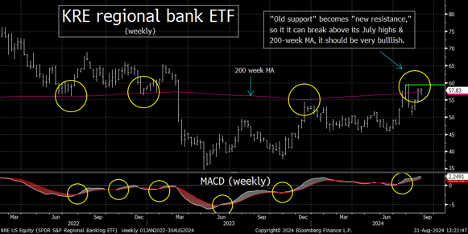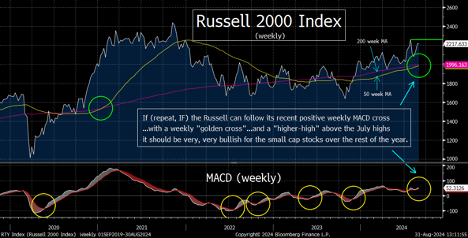Zinger Key Points
- The stock market has lost momentum in the past 10 days but it's a normal and healthy correction after a 10% rally
- Regional bank stocks have signs of a sustainable rally in the small cap sector
- Wall Street veteran Chris Capre is going live April 9 at 6 PM ET to reveal a short-term strategy that just returned 195%—in the middle of a crashing market.
There's no question that the stock market has lost its momentum over the last 10 days or so.
However, this isn't a bad sign at all. In fact, it's normal and healthy.
After a rally of over 10% in the S&P 500 in less than three weeks, it should be no surprise that the market has taken a "breather." This might easily just be a "sideways correction" before the stock market starts another leg and pushes to new all-time highs before the election.
A few sectors could lead the way if the market does indeed push higher, as several have already pushed to new all-time highs in recent weeks.
For instance, the Industrial Select Sector Fund (XLI) hit a record high along with the Dow Jones Industrial Average. The XLF financial exchange-traded fund has done the same. However, the one sector that everyone seems to be focusing on is the small cap area of the stock market. I argued last weekend that if the Russell 2000 index could push above its July highs in a meaningful way, it will be very bullish for the small cap sector.
This week, I want to combine this thought with some analysis on a sub-group of the financial sector, because this should give us some answers as to whether small cap stocks can finally outperform the market on a consistent and sustainable basis.
One sub-group of stocks to watch
The sub-group I'm talking about is the regional bank stocks. These stocks are very highly weighted in the Russell 2000, so their action going forward should be quite important. (Also, if you look at the IWM Russell 2000 ETF, it has been led by the movement in the KRE regional bank ETF almost tick-for-tick over the past several weeks.)
The regional banks should benefit if the economy achieves a soft landing. Theoretically, it should also benefit by the yield curve becoming dis-inverted as they get paid on longer-term rates, and payout on short-term rates.
The only problem with this theory is that economic growth is slowing, and when the yield curve moves back into positive territory after becoming inverted, it has been a clear sign of an impending recession over the past 50 years. Regional banks (and banks in general) do not do well during recessions. Of course, there is also the lingering issue of weakness in commercial real estate.
Having said all this, if the movement in the fixed income market is due merely to the drop in inflation (and not an impending recession), and the commercial real estate issue remains benign, this part of the stock market could certainly rally nicely. That, in turn, should help attract new money to the small cap sector in general, and the whole cycle could feed on itself.
Looking at the weekly chart on the KRE, it has already seen a positive cross on its weekly moving average convergence/divergence (MACD) chart. It is now testing its 200-week moving average (MA), after bouncing nicely off its 50-week MA in the early summer. That 200-week MA provided excellent support in the bear market of 2022. However, the KRE broke below that line during the regional banking crisis of 2023. That "old support" level has become the "new resistance" line for the KRE. Therefore, if it can follow its positive weekly MACD cross, with a meaningful and sustainable break above its 200-week MA, it should be VERY bullish for the regional bank group.

As shown above, since the KRE and the IWM are so closely aligned, a breakout in the regional bank stocks should be very bullish for the small cap area of the stock market if (repeat, IF) a breakout does indeed take place.
Moving to the chart on the Russell 2000, if it can break above its July highs in any meaningful way, it should be quite bullish for the small cap sector. However, there is another reason to think it will be particularly bullish if the Russell can break its summer highs. A move above the summer high would ALSO take it meaningfully above its 200-week moving average. That 200-week MA provided tough support in 2022, which became tough resistance in 2023. So, if it can break back above that line in 2024, it's going to be very, very bullish.

I think it will be tough for regional banks and the small-cap stocks to break out from current levels. I just don't see the economic strength to create that kind of breakout… and thus there could indeed be the kind of decline frequently seen in the fall months.
HOWEVER, it's an election year… so anything can happen. Traders should remain very nimble going forward. IF these two groups can indeed break out in the coming days or weeks, September and October could look very different than in recent years.
Learn the trading strategy behind My 7,847% gain. It’s the same one hedge funds pay $50,000 a year for. Get My $50,000 Secret Now
Image via Shutterstock
© 2025 Benzinga.com. Benzinga does not provide investment advice. All rights reserved.
Trade confidently with insights and alerts from analyst ratings, free reports and breaking news that affects the stocks you care about.